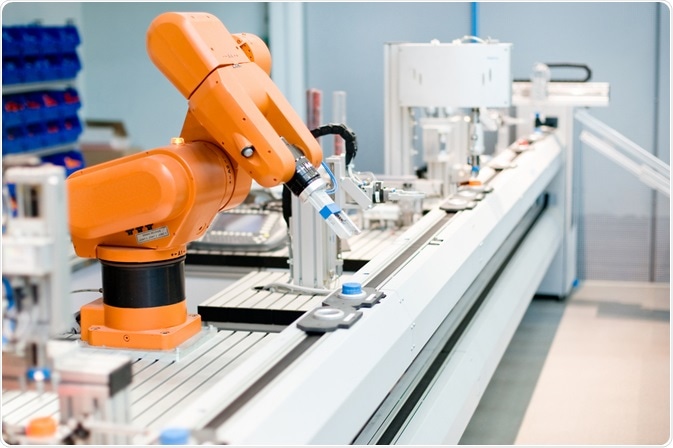Why automate cell cultures?
Laboratories that are involved in the scientific fields of cell biology, cell signaling, pharmaceuticals, protein expression, cancer biology, regenerative medicine, nanomaterials, and more, heavily rely on the use of cell cultures.

Image Credit: SFC/Shutterstock.com
Methods to automate cell culture systems have been established to carry out the process of establishing, growing, and maintaining cell cultures, replacing the previous systems that relied a lot on manual labor.
Automated systems can conduct all the key parts of the process that would once have been the responsibility of a lab technician, such as growing cultures in liquid, plating cultures, diluting samples, placing cultures into wells, and more.
These automated methods have gained popularity due to their ability to save time and resources, as well as boosting the accuracy and quality of samples.
Without automation, the production of cells and cell products via cell culture is a tedious and time-consuming process. Specific environmental parameters that are suited to the cells must be maintained during all stages of the process, from cell growth and harvesting to reseeding and analyzing.
The media in which cells are grown must be carefully controlled, with freezing and thawing rates managed to ensure consistent and viable cell lines.
Furthermore, lab technicians working with these cell cultures require full training to acquire the skills necessary to conduct this process properly and thoroughly, without any errors and without contaminating the cultures.
Any mistakes that are made during the process can be very costly, especially when high volume cell cultures are required. For this reason, many laboratories, especially pharmaceutical laboratories, have invested in automated systems of cell culture.
Lastly, due to the strict standardization requirements, and increased throughput demands in both academia and industry, the use of automated systems have become almost mandatory.
Advantages of cell culture automation
The most notable advantage of using automated cell culture processes is that it replaces the hours of repetitive manual work that has to be done by competent personnel with instrumentation. This means that skilled laboratory technicians can be redeployed in areas of the business where their expertise is more valuable.
This saves on the costs associated with this manpower and allows businesses to dedicate their resources to more profitable areas, such as research and development.
Another key advantage of using automated cell culture processes is that machinery can be programmed to carry out cell culture tasks with a higher level of precision than humans can guarantee. Plus, they are not impacted by human factors, such as tiredness and carelessness.
This means that automated systems have lower error and contamination rates, improving the quality of the cultures and reducing the costs of mistakes.
Also, machines can work faster than humans, and do not require breaks; therefore, this enables automated systems to create cell cultures at much higher speeds than human personnel.
Finally, the implementation of automated systems removes certain health and safety risks posed to lab technicians. For example, the laborious nature of cell culture processes leaves workers vulnerable to repetitive strain injury.
The process of cell culture automation
Many different companies have developed their versions of cell culture automation systems. Each system works slightly differently and has varying capabilities. These systems also differ depending on their intended use. An overview of how such systems work is given below.
Some systems are designed to automate cell culture for use in drug development automate the production of cells, as well as the membrane preparation and in vitro screening steps. These systems were initially developed to simplify the process of producing large quantities of viable membranes necessary for drug development work.
Other, more generic systems of automated cell culture have been designed by applying industrial automation methods to manual processes of cell culture.
These systems require no human supervision, a robotic arm replaces the human component in these processes, which is programmed (the robotic arm) to select cultures from the automated conveyor and carry out all necessary tasks without the need for human intervention. Structural biology and drug discovery have been using these kinds of systems extensively.
Finally, some systems have been designed for overcoming a certain limitation (i.e. growth of contaminants during incubation) of a manual cell culture. There are also established cell culture automation systems that have completely redesigned the cell culture process instead of mimicking the manual method version.
Sources:
- Kempner, M. and Felder, R. (2002). A Review of Cell Culture Automation. JALA: Journal of the Association for Laboratory Automation, 7(2), pp.56-62. https://journals.sagepub.com/doi/10.1016/S1535-5535-04-00183-2
- THOMAS, R., CHANDRA, A., HOURD, P. and WILLIAMS, D. (2008). Cell Culture Automation and Quality Engineering: A Necessary Partnership to Develop Optimized Manufacturing Processes for Cell-Based Therapies. Journal of the Association for Laboratory Automation, 13(3), pp.152-158. https://journals.sagepub.com/doi/full/10.1016/j.jala.2007.12.003
- Triaud, F., Clenet, D., Cariou, Y., Le Neel, T., Morin, D. and Truchaud, A. (2003). Evaluation of Automated Cell Culture Incubators. JALA: Journal of the Association for Laboratory Automation, 8(6), pp.82-86. https://journals.sagepub.com/doi/full/10.1016/S1535-5535-03-00018-2
Further Reading
Last Updated: Feb 19, 2020